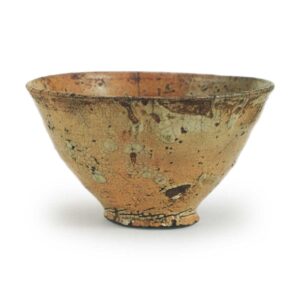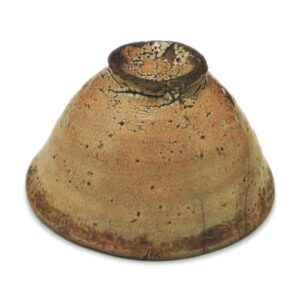

Height: 7.6 – 8.0cm
Diameter: 13.7 – 14.0cm
Foot diameter: 5.3cm
Height at same point: 0.8 – 1.0cm
It is said that this name came about because Kosho Kobori obtained and treasured this tea bowl in Rokujizo, southeast of Fushimi in Kyoto. Rokujizo is a place name on the road from Shishifushimi to Uji.
Both in shape and color, this is a light and bright tea bowl that is very nimble and elegant. It differs slightly from the usual Koido style, but as you would expect from a tea bowl that is said to be in the style of Enshu, it has a natural elegance and subtle beauty.
The brownish-red clay on the foot of the rim contains a considerable amount of iron. The brownish-red color of the Ido tea bowl is mainly due to the effect of the iron in the clay, and the reddish-brown color of this tea bowl is also due to the subtle effect of that iron.
The shape is generally thin, but the gentle expansion from the body to the rim is a direct reflection of the richness of the Oido. However, the foot is low and open, and is a completely different style to the usual bamboo joints. This is thought to be because the whole piece is thin and small, and so it was inevitable that the foot would be made in this style, but it is also a beautiful shape. It is important to note that just by changing the shape of the foot ring, the overall tone of the piece can be completely transformed.
The glaze is glossy and the gradation of the reddish loquat-colored glaze is truly beautiful. In general, the waist of the piece is a deep reddish loquat color, and near the rim it gradually becomes a bluish milky white. In addition, large and small cracks can be seen all over the surface, and in particular, in places where the glaze has accumulated in droplets, such as the inside and outside of the foot ring or the inside and outside of the bowl-shaped surface, the relatively thick glaze layer has become mottled, rising up in a bluish-white color, and unusually large cracks can be seen. This mysterious charm is what makes this tea bowl so attractive. The inside of the bowl is also interspersed with a snail-shaped tea stain, a whorl-shaped tea pool, and eye marks, but they are not so distracting that they detract from the overall effect.
In addition to the bags and boxes, there are three transfer documents from around the Keio era. The inner box is paulownia, and the “Ido tea bowl” writing is by Enshu. The bag is a rare dark green cloth with light brown yellow Roman characters, thought to have been brought from the Netherlands, and there is also an old bag with a white background and a lion design.
According to the transfer document, it was passed down from the Kobori family to Ippei and Nihei of the Manyaya store, and in 1866, it was sold to Tanimatsuya’s Toda Yashichi (Rogen) for 3,500 ryou. The following year, in February, it was sold from Tanimatsuya to Fukuhukuya Hyosai of Kanazawa, and then in March of the same year, it was sold to Tsuchiya Sahei, and later moved to Osaka again. It is said that the tools were sold for 500 gold pieces at the auction.



